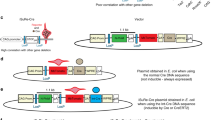Abstract
Inducible Cre–ERT recombinase technology is widely used for gene targeting studies. The second generation of inducible Cre–ERT recombinase, hemizygous B6.129S-Tg(UBC-cre/ERT2)1Ejb/J (hereafter abbreviated as Cre–ERT2), a fusion of a mutated estrogen receptor and Cre recombinase, was engineered to be more efficient and specific than the original Cre–ERT. The putative mechanism of selective Cre-mediated recombination is Cre sequestration in the cytoplasm in the basal state with translocation to the nucleus only in the presence of tamoxifen. We utilized both a reporter mouse (B6.129 (Cg)-Gt(ROSA)26Sor tm4(ACTB-tdTomato,-EGFP)Luo/J) and endothelin converting enzyme-1 floxed transgenic mouse line to evaluate Cre–ERT2 activity. We observed spontaneous Cre activity in both settings. Unintended Cre activity is a confounding factor that has a potentially large impact on data interpretation. Thus, it is important to consider background Cre activity in experimental design.




Similar content being viewed by others
References
Brake RL, Simmons PJ, Begley CG (2004) Cross-contamination with tamoxifen induces transgene expression in non-exposed inducible transgenic mice. Genet Mol Res GMR 3:456–462
Feil R, Wagner J, Metzger D, Chambon P (1997) Regulation of Cre recombinase activity by mutated estrogen receptor ligand-binding domains. Biochem Biophys Res Commun 237:752–757
Gossen M, Bujard H (1992) Tight control of gene expression in mammalian cells by tetracycline-responsive promoters. Proc Natl Acad Sci USA 89:5547–5551
Indra AK, Warot X, Brocard J, Bornert JM, Xiao JH, Chambon P, Metzger D (1999) Temporally-controlled site-specific mutagenesis in the basal layer of the epidermis: comparison of the recombinase activity of the tamoxifen-inducible Cre–ER(T) and Cre–ER(T2) recombinases. Nucleic Acids Res 27:4324–4327
Jaisser F (2000) Inducible gene expression and gene modification in transgenic mice. J Am Soc Nephrol JASN 11(Suppl 16):S95–S100
Johansen J, Rosenblad C, Andsberg K, Moller A, Lundberg C, Bjorlund A, Johansen TE (2002) Evaluation of Tet-on system to avoid transgene down-regulation in ex vivo gene transfer to the CNS. Gene Ther 9:1291–1301
Leone DP, Genoud S, Atanasoski S, Grausenburger R, Berger P, Metzger D, Macklin WB, Chambon P, Suter U (2003) Tamoxifen-inducible glia-specific Cre mice for somatic mutagenesis in oligodendrocytes and Schwann cells. Mol Cell Neurosci 22:430–440
Lois C, Hong EJ, Pease S, Brown EJ, Baltimore D (2002) Germline transmission and tissue-specific expression of transgenes delivered by lentiviral vectors. Science 295:868–872
Mishra P, Varuzhanyan G, Pham AH, Chan DC (2015) Mitochondrial dynamics is a distinguishing feature of skeletal muscle fiber types and regulates organellar compartmentalization. Cell Metab 22:1033–1044
Muzumdar MD, Tasic B, Miyamichi K, Li L, Luo L (2007) A global double-fluorescent Cre reporter mouse. Genesis (New York, NY 2000) 45:593–605
Papoutsi T, Odelin G, Moore-Morris T, Puceat M, de la Pompa JL, Robert B, Zaffran S (2015) Msx1CreERT2 knock-In allele: a useful tool to target embryonic and adult cardiac valves. Genesis (New York, NY 2000) 53:337–345
Pluta K, Luce MJ, Bao L, Agha-Mohammadi S, Reiser J (2005) Tight control of transgene expression by lentivirus vectors containing second-generation tetracycline-responsive promoters. J Gene Med 7:803–817
Ruzankina Y, Pinzon-Guzman C, Asare A, Ong T, Pontano L, Cotsarelis G, Zediak VP, Velez M, Bhandoola A, Brown EJ (2007) Deletion of the developmentally essential gene ATR in adult mice leads to age-related phenotypes and stem cell loss. Cell Stem Cell 1:113–126
Seime T, Kolind M, Mikulec K, Summers MA, Cantrill L, Little DG, Schindeler A (2015) Inducible cell labeling and lineage tracking during fracture repair. Dev Growth Differ 57:10–23
Acknowledgements
We would like to thank Baozhi Yuan and Harmut Weiler for helpful discussions, and Aron Geurts and Michael Grzybowski for Sanger Sequencing and analysis. This material is based on work supported in part by award I21 RX1440, by the Office of Research and Development, Rehabilitation Research and Development Service, and a Merit Review Award from the Office of Research and Development, Biomedical and Laboratory Research and Development Service, the Department of Veterans Affairs, and performed in the Geriatrics Research, Education, and Clinical Center at the William S. Middleton Memorial Veterans Hospital. The views expressed here are those of the authors, and the contents do not represent the views of the US Department of Veterans Affairs or the United States Government. Research reported in this publication was supported in part by National Institute of Arthritis and Musculoskeletal and Skin Diseases of the National Institute of Health under Award Number NIH AR54753. The content is solely the responsibility of the authors and does not necessarily represent the official views of the National Institute of Health.
Author information
Authors and Affiliations
Corresponding author
Rights and permissions
About this article
Cite this article
Kristianto, J., Johnson, M.G., Zastrow, R.K. et al. Spontaneous recombinase activity of Cre–ERT2 in vivo. Transgenic Res 26, 411–417 (2017). https://doi.org/10.1007/s11248-017-0018-1
Received:
Accepted:
Published:
Issue Date:
DOI: https://doi.org/10.1007/s11248-017-0018-1




